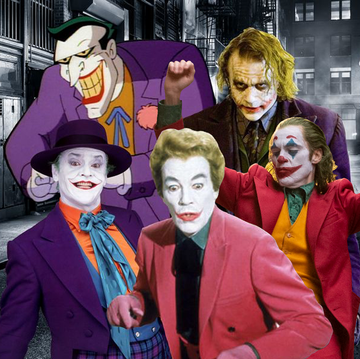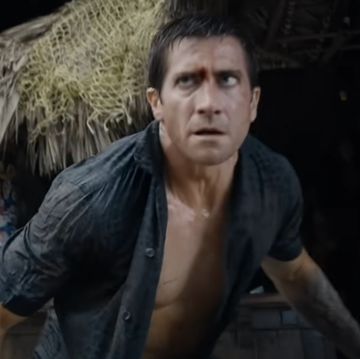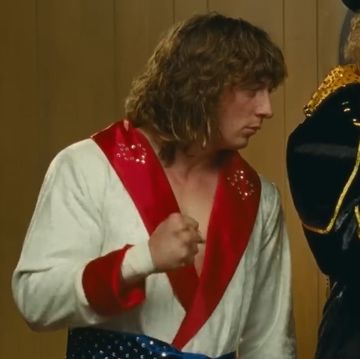Hahahahaha…HussssSHHHhhh…
The theater swelled with New York's literati as the 6:30pm showtime approached. Late-comers in search of an unclaimed seat had to brush past layers of elegantly dressed men and women, raising them to their Italian-leather-covered feet. Once everyone was settled, the curtains parted over the screen, revealing a familiar figure in a white linen suit, floppy side part, top hat and cane in hand ... an icon ... Tom Wolfe ... one of the most-celebrated writers of the 20th century. This was the sold-out world premiere at Manhattan's IFC Center—followed by an Esquire-hosted after party—of Radical Wolfe, the new documentary from director Richard Dewey that addresses a long lingering question, "Who was Tom Wolfe?"
The documentary gives context, historical and personal, to Wolfe’s prolific career in 75 fast-paced minutes. Wolfe, who died in 2018, is an elusive subject, and the film, which is based on a 2015 Vanity Fair story by Michael Lewis, seeks to reveal as much of him as possible by taking viewers through his greatest works of journalism and fiction. Among them are his seminal magazine stories at Esquire and New York as well as his best-selling books The Electric Kool-Aid Acid Test, The Right Stuff, and The Bonfire of the Vanities. The documentary reminds audiences that Wolfe inspired generations of writers—including Michael Lewis, Tom Junod, and The New Yorker's Emily Witt, all of whom appear in the film—and transports viewers to a time when writers were among the most famous people on the planet.
In the 1960s, Wolfe was among a coterie of writers that included Joan Didion, Norman Mailer, and Gay Talese, pioneering the New Journalism movement, in which reportage became more subjective and literary in nature. He started his revolution against AP style in the pages of Esquire. In 1963, the magazine sent Wolfe, who was then a newspaper reporter, to southern California to write a story on the youth culture around juiced-up custom cars. After weeks of racking up hotel bills, he returned to New York City and ... couldn't find a way to write the story. In a panic on deadline, he filed pages of notes—written in his inimitable style—hoping Esquire editors could turn them into a publishable story. His editor, Byron Dobell, thought the notes were a masterpiece. As he explains in Radical Wolfe, Dobell crossed out the "Dear/Sincerely" at the beginning and end and ran the notes in the magazines. The story, "There Goes (Varoom! Varoom!) That Kandy-Kolored (Thphhhhhh!) Tangerine-Flake Streamline Baby (Rahghhh!) Around the Bend (Brummmmmmmmmmmmmmm)…," was an explosive new vision of journalism, filled with vibrant scenes, wordplay, and onomatopoeia, a style for which Wolfe would become known.
In journalism, objectivity is a foundational tenet. If being an impartial observer isn’t drilled into your brain during journalism school or by your editor as a beat reporter, can you even call yourself a journalist? Truth. Truth. Truth. You can get sued for telling anything less than that, or worse, canceled. Yet Tom Wolfe effortlessly and fabulously blurred the lines between objectivity and subjectivity, while, at the same time, exhaustively reporting out his stories. In the documentary, Wolfe says of the objective voice, “I frankly found it absolutely boring.”
But Wolfe was also an incredibly divisive figure. He made enemies of The New Yorker after writing a savage takedown of the magazine in New York and sparred with his friends. Hunter S. Thompson, for instance, once called him a “worthless scumsucking bastard." An infamous 1970 New York article put Wolfe at odds with New York liberals and the Black Panthers, an event the documentary uses to shine a critical light on its subject. In "Radical Chic: That Evening at Lenny’s," Wolfe skewered Leonard Bernstein and his wife, Felicia Montealegre, for hosting a dinner party with New York City's liberal elite and members of the Black Panthers. But the dinner party was a fundraiser for the Black Panther's legal defense fund. Dewey, the film's director, tracked down Jamal Joseph, one of the Black Panthers who was in jail awaiting trial. The money being raised was partly for him. (During a Q &A after the screening, Dewey said Joseph had been one of his professors at Columbia.) Joseph recounts that the article had felt trivializing to the Black Panthers and their cause, and fundraising events for the Black Panthers dried up after it was published.
The winners get to write the history books, sure—but so does the person with the balls to grab a pen and publish their version of it. Although Wolfe claimed to scorn objectivity, Radical Wolfe suggests he carefully positioned himself as neither friend to the conservative right nor the liberal left. So, then, what did Wolfe stand for? Radical Wolfe tells us that Wolfe “didn’t want the world to know him.” However, as Wolfe says in the film, his goal was to always get at the truth. Was this man, born and raised in a privileged family in Richmond, Virginia, the appropriate person to tell it, whether about the counterculture of the '60s and '70s or sexual assault on college campuses like in his 2004 novel, I Am Charlotte Simmons? And is Wolfe's version of the truth even the correct one, if there is such a thing? Radical Wolfe makes these lingering questions all the more relevant today.
What we do know—and what the film portrays in a lively way—is that Wolfe's voice was frequently harsh, echoing stubbornly from his point of view, but it was always vibrant. His voice echoes through decades of American history, having empowered journalists to tell stories in new and innovative ways. Whether we like it or not, it's a voice that helped define America in the late 20th century.
Following the premiere, Esquire hosted an afterparty in one of Manhattan’s most crowded spots on a Friday night, Jac’s on Bond. The room swelled with admirers of Wolfe, young and old, some donning white suits of their own, dressed as if awaiting the approval of Wolfe’s discerning eye. Different generations discussed Wolfe’s work, his style, his enemies. Cocktails flowed and trays of hor d'oeuvres floated by (though none as lavishly prepared as the Bernstein’s “Roquefort cheese morsels rolled in crushed nuts”). Small bands formed around Gay Talese, Michael Lewis, and Tom Junod; the actors Matthew Rhys and Keri Russell were tucked away in a corner chatting with guests; Tom Wolfe's widow, Sheila, and his daughter, Alexandra, mingled; members of the fashion crowd, including chef, model, and hotel owner Rōze Traore turned up. Wolfe would have relished them all.
Radical Wolfe is playing in select theaters.
Read some of Tom Wolfe's most-famous magazine pieces for Esquire:
- There Goes (Varoom! Varoom!) That Kandy-Kolored (Thphhhhhh!) Tangerine-Flake Streamline Baby (Rahghhh!) Around the Bend (Brummmmmmmmmmmmmmm)…
- The Last American Hero is Junior Johnson. Yes!
- The Tinkerings of Robert Noyce
- The Marvelous Mouth of Cassius Clay















